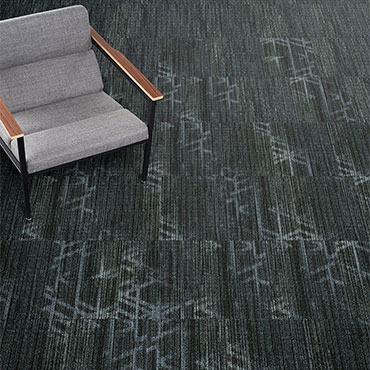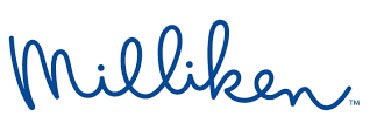The Complete Guide to Printed Carpet

Printed carpet offers unparalleled design flexibility and creative freedom. Designs can be made to match perfectly from tile to tile, and vary hugely in size – from high-resolution half-inch patterns, to patterns as large as your floor plan.
New technology made printed carpet available for the first time, more than 40 years ago. Since then, decades of technical refinement, improvement and development have enhanced design possibilities with printed carpet - but despite that, there are still many myths and misconceptions surrounding printed carpet.
We've pulled together everything you need to know about printed carpet, to dispel these myths and share the creative possibilities that printed carpet offers.
What is Printed Carpet?
There are several common processes used to add color and patterns to commercial carpet:
Yarn dyeing - this is the process of coloring white yarn, with each fiber dyed a single color before being tufted into carpet. Yarn dyeing typically adds a single color to each fiber, but a process known as space dyeing can be used to add several colors down the length of the fiber. When these yarns are tufted into a backing material, it creates horizontal ‘stripes’ of different colors.
Solution Dyed Nylon - Solution dyed nylon (SDN) is a process that dyes yarn as it’s extruded, coloring the fiber as it’s made. Carpet created this way can resist bleach solutions of up to 10% concentration – a property which other processes can only achieve with the application of a topical treatment.
Continuous Dyeing - Continuous dyeing is a 'post-dyeing' process, meaning the dye is applied once the carpet fibers have been constructed. The fabric is passed through a dye ‘waterfall’, and by using multiple applicators and different dyes, it’s possible to create a huge range of different colors and shades of carpet.
Digital Dye Infusion - This is the technical name for printed carpet. It uses the same dyes and fixing processes as yarn dyeing, but unlike yarn dyeing, the dye is injected after the textile has been constructed, with the dye penetrating directly into the carpet fibers. This makes it possible to create extremely accurate, high-definition patterns and color gradations, in very specific locations on the textile.
Milliken has been using the digital dye infusion process to create printed carpet for over 40 years. Since its inception, the technology and processes have been developed and refined, and this proprietary dyeing process offers the ultimate in design flexibility and freedom, without compromising on durability or quality.
While the digital dye infusion process is often referred to as 'printing', that description is something of a misnomer. Rather than being printed onto the carpet tiles, dye is chemically bonded into the carpet fiber, meaning the finished product is durable and long-lasting, as well as beautiful.
3 Printed Carpet Myths
Thanks to the ambiguity of the 'print' description, and a lack of understanding about the technical capabilities of the process, there are still many misconceptions surrounding printed carpet tiles. Let's address the three most common myths about printed carpet:
1) Printed Carpet is Less Durable than Other Carpet Types
One of the most common concerns about printed carpet tiles surrounds walk-off: the idea that over time, foot traffic will wear away your printed designs. However, as the dye is chemically bonded into the carpet fibers, the printed designs can withstand high levels of foot traffic with no walk-off risk. In fact, nearly all Milliken’s printed carpet tiles have received a TARR rating of Severe for appearance retention – top of the scale.
You'll even find carpets printed using digital dye infusion technology installed in airports all over the world - not exactly low-traffic areas!
2) Printed Carpet Has No Texture
Twenty to thirty years ago, printed carpet tiles were visually very flat, with little texture or depth. However, thanks to improvements in the processes and the quality of print technology, the appearance of printed carpet tiles have also improved.
3) Printed Carpet Will be Damaged by Cleaning Products
Much like the misconception that printed carpet is susceptible to walk-off, it's also wrongly assumed it will be damaged by common cleaning products. This stems from the fact that solution dyed nylon (SDN) is inherently bleach resistant (up to 10% concentration) - a property not shared by printed carpet, or indeed any other carpet type, regardless of dyeing process.
However, it's worth noting that cleaning with bleach will damage all carpet types - even solution dyed nylon. Bleach damages the carpet fibers, but with SDN it will take you longer to notice the damage as the dye will hold its color, whereas with other dye methods the bleach would cause the color to fade, making the damage more obvious.
Thankfully, outside of healthcare environments, bleach is no longer a common component in cleaning products. So if you’re not using bleach in your cleaning products, you don’t need to worry about your printed carpet tiles getting damaged. Alternatively, if bleach is a concern, there are topical treatments that can be applied to printed carpet to provide the same level of bleach resistance (up to 10% concentration) as SDN - making the perceived lack of bleach resistance a complete non-issue.
5 Benefits of Printed Carpet
1) Improved Design Continuity
With proper maintenance, commercial carpet can last upwards of 20 years. However, in that time it's likely you'll have to replace sections or tiles that become particularly worn or damaged.
If you're replacing tiles, it's crucial that you can get an exact color and pattern match, or else the new section will stand-out and be even more noticeable than the damaged part you replaced. With printed carpet it's easy to recreate colors and patterns, even several years after the original purchase. However, for other dye technologies it's less certain: suppliers may drop product ranges and dye colors as changing trends impact popularity.
This is a particular problem with SDN products: the manufacturer is required to manage and maintain extensive yarn banks that will change over time. As they change it's not possible to maintain the same color options that were once offered. However, with DDI you have virtually unlimited colors to choose from, and as it's a post-dye process, the same complex yarn banks don't need to be maintained as color and pattern can be applied to any carpet tile.
2) Lower Lead Times and Order Minimums
Digital dye infusion creates carpet designs onto blank textiles.Manufacturers don't need to keep an inventory of different colors and designs; instead, your chosen patterns and designs can be created quickly and efficiently when you order.
In comparison, carpets that use solution dyed nylon require the manufacturer to hold inventory on popular designs in order to meet short lead times. If you prefer a non-standard color or pattern you may experience extended lead times as the manufacturer looks to acquire the required yarn and works your order into their manufacturing work flow.
3) Unparalleled Design and Pattern Capabilities
Using the latest print technology, digital dye infusion makes it possible to create large-scale designs across multiple carpet tiles. The combination of digitally-controlled color with precise registration means you can create striking patterning and visual effects. Each tile can be made to repeat, match from tile to tile, or even be completely unique.
4) Variety of Color and Texture
It's not just patterning that printed carpet excels at - the variety of colors available is unrivaled by other carpet dye methods. Digital dye infusion makes it possible to print a huge variety of colors and color gradations onto your chosen carpet.
So if you want carpet in your company colors, or to perfectly complement your chosen palette, printed carpet offers the opportunity to personalize your design choices, thanks to the technological capabilities that can't be replicated with other carpet types.
5) Unbeatable Design Freedom
In short, thanks to Milliken's proprietary digital dye infusion process, printed carpet offers unbeatable design freedom, combining flexibility with longevity. You can create colors, patterns and even personalized designs that simply cannot be replicated with other carpet dye processes, or other flooring types.
What to Look For in Printed Carpet
When you're looking for printed commercial carpet, it's easy to assume that all carpet is created equal, with little variance from one manufacturer to the next. However, not all manufacturers have the same technical capabilities, or use the same high-quality carpet fibers and tile backings. Here are two tell-tale signs of top-quality printed carpet tiles:
1) Open Cell Cushion Backing
With carpet tiles, the choice of backing is the most important decision you can make to ensure durability and longevity. There are three common types of carpet tile backing:
- Hardback
- Closed cell cushion backing
- Open cell cushion backing.
With hardback carpet tiles, the fibers directly absorb the full impact of foot traffic, which damages the fibers and causes the appearance of your carpet to deteriorate. Cushion backing helps to absorb some of the impact of foot traffic, reducing fiber wear.
However, closed cell cushion compresses over time, and eventually breaks-down until it can no longer absorb foot pressure. Open cell cushion backing offers the best long-term protection for your carpet. Instead of breaking down over time, open cell cushioning ‘re-inflates’ after compression,protecting the carpet fibers more effectively and for longer than closed cell cushioning.
2) Digital Dye Infusion Process
This world-leading print dye process is proprietary Milliken technology. It offers cutting-edge design capabilities that can't be matched with other carpet dye processes or technologies. If you want to fully embrace the design opportunities and flexibility offered by printed carpet, you should look for carpet that has been manufactured using the digital dye infusion process.
Make the Most of Printed Carpet
Think of different carpet dyeing processes as different design tools, to help match your commercial carpet with your organization's practical and aesthetic requirements. Different processes can be used to achieve different looks, and will be suited to different projects. But with so many myths still lingering, it's important to understand the truth about printed carpet, so that you're not discounting the design tool that can offer the best in creativity and flexibility, based on misconceptions that are 40 years out-of-date.

.jpg)




























